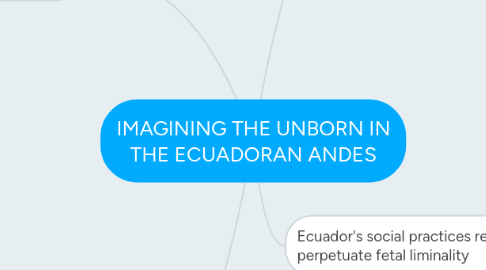
1. Gestational Development
1.1. The U.S. has access to books, posters in physicians' offices, and plastic models depicting gestational development
1.1.1. visual models and books are helps to create an image and meaning attached to particular gestational stages
1.2. rural highlands of Ecuador do not have visual or technologically based information
1.2.1. Women learn about intrauterine fetal development from their own experiences & talking with other women
1.2.2. unborn are not referred to in gendered terms
2. Building Persons is a Woman's Responsibility
2.1. physical separation of the fetus from mother at birth is an important step acquiring personhood
2.2. newborns continue to be dependent on their parents to provide spiritual sustenance and physical strength
2.3. fathers and mothers are held accountable for safeguarding fetuses
2.3.1. must respond to pregnant women's cravings , abstain from sexual relations for the forty-day postpartum period, and remain faithful to their wives
2.3.2. colerin
2.3.2.1. One of the most feared infant diseases in San Gabriel
2.3.2.1.1. When father upsets wife
2.4. Much of the U.S. debate over abortion has centered around identifying the most defensible moment at which personhood can or should be assigned
3. Ecuador's social practices reinforce and perpetuate fetal liminality
3.1. Rural highlands of northern Ecuador, view the unborn as liminal, unripe, and unfinished creatures
3.1.1. Adults are slow to assign individual identity and personhood to the not-yet-born and the newly born
3.1.1.1. often called criaturas
3.2. Abortion is illegal and condemed but there is little enforcement and laws
3.3. The civil registry does not have wellestablished or well-enforced procedures for counting live births, fetal deaths, or infant deaths
3.3.1. no social consensus for determining how to handle fetal death
3.3.1.1. Even if the state were more aggressive about collecting these vital statistics, compliance in the hinterlands could not be guaranteed.
3.4. Un secreto a voces (an open secret)
3.4.1. people in Ecuador describe the availability of abortion
3.4.2. illegal but highly available
3.4.2.1. The Ecuadoran Constitution changed in 1978 to specify that "a child will be protected from conception onward."
3.4.2.2. Civil Code (Article 61) specifies that "the law protects the life of the unborn"
3.4.2.3. Penal Code (Articles 441 through 447) specifies the penalties for abortion
3.5. Auca
3.5.1. persistence of faith in Auca is the best evidence of the ambuguity of the unborn in the highlands of ecuador
3.5.2. metaphor for the uncivilized and for several categories of quasi-person
3.5.2.1. described as frightening and potentially dangerous; could turn themselves into ghosts or cannibals.
3.5.2.2. The auca shapes the meanings attributed to the unborn and to babies who die prematurely or without church protection
4. Emergence of fetal persons
4.1. social relationship between born and unborn
4.1.1. "in effect an ideological mechanism to turn social facts into natural and therefore immutable facts."
4.2. social practices that constitute fetuses
4.2.1. come from the fields of medicine, ethics, religion, journalism, law, technology, entertainment, politics, and the academy.
4.2.2. Some practices are nationally specific
4.2.2.1. In Ireland, the contents of women's wombs have become implicated in debates over membership in the European community
4.2.3. practices include are large, public assertions such as Operation Rescue demonstrations or anti-abortion bill-boards
4.2.3.1. Other constitutive practices occur in private
4.2.4. North Americans individualize, personify, & even glorify fetuses as "super-subjects"
4.2.4.1. U.S. conventions mandate that people should distinguish among the children socially erased by miscarriage or induced abortion
